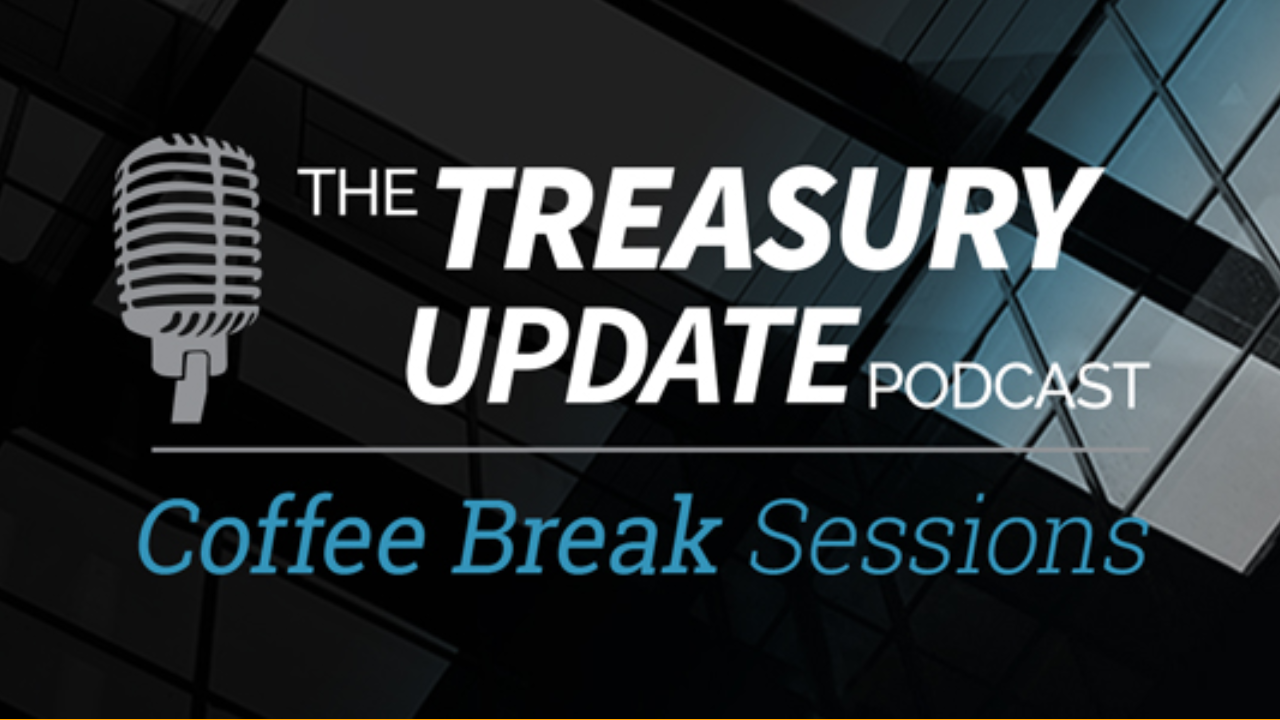
Episode 214
The Strategic Treasurer Series: Treasury Roles (Part 1)
Host:
Craig Jeffery, Strategic Treasurer


Speaker:
Paul Galloway, Strategic Treasurer


Subscribe to the Treasury Update Podcast on your favorite app!
Episode Transcription - Episode #214 – The Strategic Treasurer Series: Treasury Roles (Part 1)
Announcer 00:04
Welcome to the Treasury Update Podcast presented by Strategic Treasurer, your source for interesting treasury news, analysis, and insights in your car, at the gym, or wherever you decide to tune it.
Craig Jeffery 00:17
Welcome to the Treasury Update Podcast. This is Craig Jeffrey. This session – treasurer roles and development dialogue of three roles and overview – is the first part of a four part series on Treasury roles and development. Operational effectiveness and strategic excellence is part of this. It is a short series that explores the different types of roles within treasury. Some responsibilities are by nature, highly operational and exceedingly important and necessary. And yet other responsibilities are more strategic in nature and require foresight and excellence in planning, relationship management and financial analysis. While each position tends to be oriented heavily in one direction, there are positions that are hybrid using a combination these roles. What can we learn about these different activities and roles in order to be more effective in our careers, and more helpful to our organization? What assumptions should we challenge? How do we leverage our strengths and develop some, at least some of our weaknesses? I’m joined today with a senior advisor from Strategic Treasurer, Paul Galloway. Paul, welcome to the podcast. This podcast will be much more of a back and forth discussion, a little bit less heavy questioning on one side. So we’re excited to talk about this. We’ve we’ve, we’ve had this discussion about roles, functions, areas of emphasis that people have. And I think it’s helpful to have this discussion as we think about developing our careers. Maybe we could begin Paul, we could talk about the three types of roles as we’re defining them, then maybe get into some of the activities that treasury does, treasury and finance has to perform, and how those may fit into one or the other, or the third category.
Paul Galloway 02:00
Yeah, Craig, treasurers are required to do a couple of different things in terms of roles. Traditionally, people think of a treasurer having an operational role. And the operations side of things is where the treasurer owns cash and does the blocking and the tackling and moves, you know, they move the cash around, they ensure that the organization has liquidity, that their operating unit has the funds available to execute business daily activity, if there’s an investment arm, they will ensure that the investment side of the house also has cash needed to sell trades or move money around. More and more today, we’re seeing the treasurers being called upon to take on a strategic role. The strategic side of things requires a different mindset. And so these are bigger decisions, you’ve got to get the decisions correct. And so treasurers spend time working on projects related to strategy, or things that will drive the business forward in terms of things that are going on on the cash side or on the balance sheet. What we’re seeing is some organizations that treasures can have one or either role, either operational, or they can be strategic. But in some instances, they are taking on a hybrid approach. They’re doing both strategic and operational things. They’re required by the business, some of that is size of the organization, the way the organization is structured, in just the demands of day to day business may require that treasurers that are strategic dive into operational side of things on a daily basis. And the challenging thing I think, for hybrid roles for treasures is they may be working on the operational aspects, which is high stress, fast paced, and then turn around in the afternoon, I’d be required to start working on a project tied to a strategic initiative. And it’s a different mindset.
Craig Jeffery 04:22
Yeah, it’s a different mindset. Sometimes it’s a different set of skills, that rolls into that. You know, as we think about strategic, operational, and hybrid, maybe we could talk about some tasks and then link some of these to those particular characteristics or the strategic role and operational role in a hybrid role. I just want to emphasize these are all extremely important activities. They’re different. They’re all necessary, and there’s much we can learn and we’ll learn through the series. And I’m sure a lot of the people that are listening, have additional items or thoughts that they can weigh in on. We’d love to talk to you about this, whether it’s on a podcast or otherwise, I think there’s quite a bit more in this broader topic. But Paul, as we think about task, you mentioned, cash positioning and forecasting, moving funds to mobilize that activity that falls pretty well into the operational type role. On the strategic side, maybe you could list a couple different type of tasks or responsibilities that fall, fall there, like specific things I’ll give, I’ll start with one like investor relations might be one activity.
Paul Galloway 05:31
Yeah, investor relations certainly could be an activity tied to a treasurer’s role. And then obviously, when it comes to investor relations, it’s how you communicate to investors. And in Wall Street, you have analysts that are monitoring what’s going on with organization. And from a treasurer’s perspective, there can be a close tie to investor relations, whether that’s something that is a function within the treasurer’s or view meaning that they oversee it, or it could be in direct tandem with the role as it reports to the CFO of the organization. But from a investor relations standpoint, you know, as a treasurer, I think the things that would be of note would be the cash position of the organization, in the ability to draw upon cash, meaning they’re able to fund the activities of the day to day organization. But there’s another component to it, that is important, which is the capital funding. And oftentimes treasures are part of the capital funding, or capital raising for the organization. So these are strategic balance sheet moves that are being made, in terms of how they fund everything that the organization wants to do. And so that can come in the form of mergers and acquisitions, the development of new products and services. It could be share repurchases, or it could be other activity that the organization is engaging in. And so the treasurer’s role in funding, the balance sheet becomes more and more important. And of course, in tandem with that, which we’re going to switch from the investor relations standpoint, to rating agencies, so treasurer’s often own relationships with the rating agencies, which is really important to organizations. So they spend a lot of time providing information to these organizations so that they understand the company’s financial health and come up with a determination of what that means in terms of ratings.
Craig Jeffery 07:51
Those are some good examples, you know, on the strategic side, as well. And risk management falls into that as well. And I know we have a whole session we’ll talk about the strategic roles and activities. You know, as we think about the vision of an organization and a mission of a treasury group, that usually involves protecting cash, providing for cash, things related to cash, liquidity management, capital structure, superintendent of payments, and a number of other activities, those activities tend to fall across some of these roles. So if you say for example, Treasury is the owner of cash, not an observer of cash, not the overseer of cash, but the owner. This has implications for bank relationship management, that ties into your comments about capital structure, accessing the, you know, the debt markets, and it has a role from how do we run the day to day business? So that type of responsibility carries with it strategic operational and probably hybrid activities as well. That’s one example. I didn’t know if you had another example, we could talk about these key responsibilities and how they lay or filter out into these different categories.
Paul Galloway 09:05
Yes, certainly, owner of caches is a prime example another one that I think is equally important is the manager of liquidity. And so, treasures often own the liquidity component because with owner of cash, liquidity is is important. There can be gaps in the activity of the organization, you have to have access to liquidity, which can come in various forms, and being able to forecast what the demands on liquidity might be, or what they could be, is really important and also understand where are the risks to the various liquidity components meaning that hey, you might not get exactly what you need when you need it because of various things. What could impact that meaning that something I expected comes up puts a demand on liquidity that you weren’t anticipating, you have less liquidity available for other activity that normally occurs. So, manager of liquidity, I think is one of those items that a treasure owns and is pretty important. There’s there’s a couple others that are also important. But that one, you know, is is front of mind from an operational standpoint.
Craig Jeffery 10:31
Paul, I know, you’ve seen these charts where there’s a triangle with the point facing up in the flatline on the bottom. And then you also have a usually a corresponding picture where there’s a triangle pointing down. The triangle that points up and the bottom section is all operational in the very top is strategic, you know, and analytical might fall below that. And then there’s this wonderful consulting approach says we’re gonna move from more strategic or more operational and tactical, to more tactical and strategic. And that’s the flip side. So we want to make sure we can do more analysis. And this is commonly put out by by organizations saying we want to move in this direction. And without saying, the usefulness or some of the silliness about that. Cuz there’s certainly some usefulness, and overplaying that. What does this mean? Does this mean that operational is not important? It doesn’t mean that the strategic and analytical is the only value. How should we think about this, as we say, we want a more thoughtful group, a more strategic group, but nothing will function, if you don’t have the operational side functioning well, and doing what it needs to do. Maybe you could talk to that
Paul Galloway 11:46
The operational side of things are extremely important, you can’t ignore that side. Because if that’s not functioning properly, then the organization isn’t going to be able to do what it needs to do. So being the owner of cash, or a manager of corporate liquidity, superintendent payments, whatever you want to call these operational activities that a treasurer engages, and they’re highly important, if they’re not working properly, it could be that you have certain payments and have to be in because you have third parties or you have agreements with, and they’re time sensitive, and you have to have them completed in a timely manner, not making those payments on time a manner come with consequences. The other thing is, is you gotta have the business have a need for product development and other things. And if the operating side of things aren’t working properly, to allow for the distribution, or the development of products and services, that can create problems down the road for the organization. So think about your own paycheck. Let’s say that the organization has having problems getting payroll out the door, because the operating activities not working right, or your vendors that you use on a regular basis, or your customers that you’re making cash payments to for various things, when those payments or those transfers aren’t occurring as they should, that’s a problem. So the number one thing I think a treasurer wants is to never have anybody say anything about what’s going on on the operating side, meaning that it’s running so smoothly as doing, you know, they’re doing everything that should be done as being done in an efficient, timely manner. There are errors that are failures that are fraud, or all these things that can happen to disrupt the operational side. If you’re able to do that, that’s huge.
Craig Jeffery 13:57
You know, Paul, one of the things that came to mind when we’re talking was, you know, when you complete a deal you do a bond offering or the corporate bankers or the investment bankers, you know, create these tombstones these Lucite or glass etched items that explain what the deal is, there’s some sort of memento to trigger that and to be placed on on the shelf, signifying what happens. We tend not to have that on the operational side. And I wonder if that has, has any influence on is this important or not? Or is this just a way of capping a project and we have a project mentality in our businesses to celebrate the completion of something significant that has a box around it?
Paul Galloway 14:45
I can tell you just past history, myself, getting a tombstone for an m&a transaction or raising capital or something else, a big project that was completed, you know, that’s certainly a good feeling. and I can look on my shelf. And I can look back at those and say, Yeah, you know, that was a great experience, it was super challenging and really difficult and really important. We succeeded, you do not get that on the operational side of things. Unfortunately, it’s just the way it is right? The activity is not long lasting in the sense of moving money from one account to another account, or from one bank to another bank or from your company to another company. People don’t give you accolades for that, they don’t congratulate you for doing your job every day, when you come in, and you do the walk in, you don’t get that right. So I can definitely see how folks might think, Geez, the operational stuffs really not that important. Look, you know, you don’t have anything to show for it. But the end of the day, that’s not true. If you in a treasury environment, are able to say, Hey, I’ve done this job for the past 10 years, and I’ve had little to no fraud activity, I’ve been able to make all payments, timely, everything is been efficient in how we’ve approached managing cash, we’ve increased the cash yield, we’ve maintained liquidity, we have proper balance sheet financing, the organization is able to execute on all their projects in a timely fashion. Because we’re able to provide them with the cash when they need it. At the end of the day, if you’re able to say that that’s the tombstone.
Craig Jeffery 16:47
It’s interesting, you know, I think when we have there’s projects, let’s say there’s a technology implementation project, or you’re moving some or all of your activity to a new banking structure at new banks or new institution, there might be T shirts, mugs, some type of swag, that might be one way of celebrating, but, you know, instead of us feeling bad about the operational activity and the lack of tombstones, I always, I always come back to who has it worse. And I think about payroll, you know, if someone has, if someone makes a problem with payroll, people are upset, they’re in payroll’s face, maybe not in their face, but they’re on it. It’s urgent and has to be resolved. Lots of negative feedback about it. But nobody goes back and says, Hey, thanks for two years, no problems at all. My entire department. All the payroll items have been right, payrolls hit, it’s done. Thank you for excellent. They only get negative attention.
Paul Galloway 17:46
Yeah, no doubt. That’s definitely something that gets noticed.
Craig Jeffery 17:50
So this is not the payroll update podcast. But I always think of those, I think you would surprise someone maybe to the point of shock, or putting them in a coma, if he went to payroll and said, or human resources. Thanks for getting this right for so many years in a row. That’s really awesome. They probably wouldn’t know what to say. If anybody does that, let us know how that how that works. You know, Paul, I know we’re gonna be talking about each of these areas. But I wanted to just spend a few moments talking about automation and reporting. I’ll make a few comments, feel free to jump in?. How is how does automation impact each of these areas? How does reporting matter, I’ll just say a few things that we can either explore a bit now or certainly more in depth later. Just a couple thoughts on a reporting standpoint, good reporting tends to be done on a weekly monthly, whatever basis, that tends to be operationally focused, that tends to be the biggest area of attention to monitor what goes on. Reporting on the strategic side, or at the macro level tends to be done more outside of a core system. It’s more ad hoc, and maybe not as automated. A second area we talked about, not just automation, but maybe, you know, benchmarking or making comparisons historically, benchmarking has been almost solely the focus on the operational side, whether it’s collection receivable, treasury, it’s what’s our cost per collected item, number of items, process per person, some of those items. And now I think we see more of this benchmarking, we definitely see more of this benchmarking moving into some of the strategic and hybrid roles and models and responsibilities, like payment security, like technology structure, how do you do a comparison there? How do you benchmark against what’s you know, what does it mean to be using modern tech? How do you compare against others? What are the standards? So I think there’s some changes there. So how does that as automation and some of these changes, how is that impacting maybe these different different roles?
Paul Galloway 19:55
I can tell you from my recent experience, where try users are being required to focus now is definitely around this benchmarking aspect. More and more often, you’re seeing that treasures are working directly with their FPNA teams, they are working with their budget teams, they’re working with other people within the organization to understand demands or things that may impact a demand on cash, the or utilizing technology to generate reports that provide information relative to a forecast. So they look at they do look back, say, they look at various analyses, they set certain metrics in place that could be, you know, KPI, a key performance indicator, or something tied to an objective by the organization for the year. And so treasures more often are required to engage within the organization, and engage utilizing technology to generate information that helps senior managers understand what’s going on with the organization, and helps them with decision making. These metrics, that reporting is becoming less and less ad hoc, although you’re always going to have some components that for various reasons, you’re seeing more and more often, that they’re automating these reports that are accessing data and information from organizations data lake, and compiling that with information that are drawn out of a treasury management system. And they’re bringing data together to inform that’s really important, I think, nowadays, and that’s where some of the strategic aspects of a treasurer’s role come into play.
Craig Jeffery 19:55
Yeah, that certainly does. I mean, there’s so much so many changes technologically that have a have an impact on all parts of Treasury and and all of these, each of these three roles, and I’m looking forward to exploring that in more depth through some of these discussions. We’ll just give a little shout out to the next podcast session, that series will talk about the strategic role go into how do you balance between different strengths that you have? How do you work with other areas? How it looks different from one type of organization to another, and then we’ll move through the operational roles and the hybrid roles and bring up some of these other points into it. Paul, any any final thoughts? Before we sign off?
Paul Galloway 22:06
Craig, you know, I think this is just a really good discussion around how the treasurer’s role has been changing over recent years, you brought up some really important aspects around how the operational side of things are still very important. And we can’t lose sight of that. So it’s good to understand the different roles. It’s also good to understand that they’re all very important.
Craig Jeffery 23:19
Thanks, Paul, for your your comments today and insight on Treasury roles. Thank you also to our listeners. At the very end of July, the Treasury Update Podcast passed a quarter of a million downloads. I don’t think we ever expected that to occur. It’s listened to in over 150 countries. I know that was that exceeds the number that we’re expecting by more than triple over time. So thank you, for those who listen. So sure, for those who listen all the way to the end, where this announcement may be heard. Thanks so much for taking the time to engage on Treasury through the Treasury Update Podcast.
Announcer 23:59
You’ve reached the end of another episode of the Treasury Update Podcast. Be sure to follow Strategic Treasure on LinkedIn. Just search for Strategic Treasure. This podcast is provided for informational purposes only, and statements made by Strategic Treasure LLC on this podcast are not intended as legal, business, consulting, or tax advice. For more information, visit and bookmark StrategicTreasurer.com.
Related Resources
Global Payments Survey
The goal of this survey is to obtain a complete view of the global payments environment as it pertains to the treasury and AP functions and identify which payment technologies and processes are top of mind for practitioners heading into the next several years.








